Day 5: At the end of the world
21 February 2007
12:00 AM
Torres del Paine — Day 5
February 4, 2007
Our last day of hiking would be our longest. We had 12 miles to cover. If you believed the map, it would take us six hours to do it. I woke up with legs as stiff as boards, especially in my calves, although I couldn’t say how much I attributed to hiking and how much was due to squatting at the stove last night. It wasn’t until I had inflicted considerable damage on my legs that Amanda pointed out that I could sit on my sleeping bag rolled up in my stuff sack. Live and learn, I say.
On our way out of the camp we crossed a well-constructed bridge with a worrisome sign: ONLY TWO PEOPLE ON BRIDGE AT A TIME. What do you suppose would happen if we put three people on here? I wondered. Or would you have to use four before it got exciting? “Are those two people with backpacks or without?” Amanda added to my concerns. We moved across quickly leaving little time to answer our quandaries. Before long we had traded the darkness of the French Valley for another sunny day on the trail. We met up with our old friend, the still unpronounceable Lake Nordenskjold, which looked as blue as ever. The scenery was reminiscent of our long trek two days ago. There were clear skies and a warm sun overhead. Streams en-route to one lake or another frequently crossed our path.
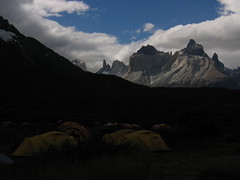
Even though we had our packs on again, my back made no complaints. I felt we had barely gotten started when we spotted our lunchtime destination two hours later. Around 1:30 we arrived at a veritable oasis on the circuit. It was just as other backpackers had described it to us: like a city. Campamento Great Paine was at the edge of Lake Pehoe. A catamaran arrived and departed twice daily with service to the park entrance. This explained both the abundant supplies and the sudden explosion of people. Dozens of tents were set up in the picturesque clearing outside the lodge with a clear view of the Cuernos and Torres. In the dining room I saw a baby, which told me that wherever we had stopped was too posh. “This is backpacking!” I hissed to Amanda. “It’s supposed to be too hard for babies!”
After our exquisite lunch—salami and cheese sandwiches, with replenished salami from the metropolis mini-mart—we hit the trail bound for our final destination, Grey Glacier. This was the last part of the W, the left arm. If the morning was any indication, we would be seeing more of the same today. It was not. I was amazed that on our last day we were still seeing new things. The afternoon held all sorts of novelties. I spotted a condor circling overhead. Amanda pointed out purple and white flowers that looked like a set of Swiss horns. We saw sheets of easily-fractured gray rock, distant snow-swept mountains, and new lakes. Still no pumas, sadly.
The trees were my favorite. They are a Patagonia trademark, a visual representation of the fact that Patagonia is the windiest place on earth. Some grew with all their branches pushed to one side. Others were twisted beyond recognition. One looked distinctly like a cartoon man trying desperately to walk against the wind. A batch in the area where we were hiking were bleached white and leaf-less; they were fallen soldiers in the ongoing battle with the wind.
One of the unexpected pleasures of traveling to Torres del Paine was meeting people from around the world. In the park we bumped into travelers from Chile, the U.S., Canada, Australia, Germany, Austria, Ireland, England, Spain, Italy, and Israel. I heard Hebrew spoken for the first time. When we overheard other people, Amanda and I tried to guess the language they spoke. I tried to decipher the accents behind the “holas!” that we exchanged in passing.
In the afternoon we ran into an Italian from Pisa who we had met earlier in the week. “Oh no!” I told him. “Your other boot’s broken now too.” The first time we saw him, he had wrapped medical tape around the toe of his left boot to keep it from splitting open. Now both shoes sported the same jury-rigged treatment. “I just need them to last a little bit longer!” he said. Then we continued in our respective directions. Sometimes the interactions with other hikers weren’t profound, but they gave a certain sense of camaraderie on the trail.
Not all interactions were good ones. Later on the trail, I was jogging to catch up with Amanda after having an extended photo shoot with the mountain. I found her waiting on the trail. “Stop,” she said to me, but her words didn’t register in my mind until I had already gone several paces past her. It was too late. I spotted the bare-butted woman squatting at the side of the trail. Apparently not everyone takes bathroom privacy as seriously as we do in my culture. I did an instant about-face, ran past Amanda for the second time, and pretended to take a picture of the distant hill to mask my embarrassment. Two minutes later, the woman and another hiker walked past us laughing nervously. “Gracias,” she muttered. Once they were out of earshot, Amanda remarked, “I guess when you gotta go, you gotta go.” Indeed.
Two-and-a-half hours into our afternoon walk we rose over a main ridge. A British hiker had described this section of the trail to us a couple nights before, saying, “You’re just so exposed on that section along Grey.” We were no longer protected from the wind as we had been climbing out of the valley. Gusts of wind were now invisible bullies pushing us around the trail. Our reward was that we got our first view of Grey Lake and Grey Glacier.
Grey Lake contains the melting water and the icebergs that break off the glacier. Having never seen a glacier or iceberg, I was unprepared for the sight. Grey Glacier is a mass of hulking ice that no description can fully prepare you to see. It is 4 km wide and 27 km long. The glacier abuts the Southern Patagonian ice field, which is the third largest ice mass in the world; Antarctica being the first and Greenland the second. Its mass conveys stillness and urgency at the same time. Though it looks immobile, it is a jagged ramp winding inexorably towards the water. The icebergs attest to that. Chunks of ice the size of automobiles—Excursions, not Smart cars—and apartments drift in the lake, floating away from their limited-time membership in the glacier. Their blue color is otherworldly, like a fiery glow captured within the frozen ice. I swore they would light the night.
On a salient ridge overlooking the glacier we were struck by a blast of chilly air. It would probably be more appropriate to say “pummeled,” or “under continuous bombardment.” It was like a battle between us and the wind. Our weighty backpacks conspired with the wind to put us off-balance. I almost fell a couple of times. Though cold, I found the air invigorating. I wanted to drink it.
Since we could see the glacier and our destination campsite was next to said glacier, I figured we would be there in no time. Seeing may be believing, but as it turns out, it is not arriving. Distances are deceiving when you are looking at big things. The rest of our hike took over an hour. Once again, the map’s estimated time was based on people faster than us. While we were plodding along, a park ranger without a pack went running past us. We had found the pace-setter for the map’s aggressive time estimates.
Our feet started to get heavy. When you get tired, your first thought is that it is enough to drop one foot in front of the other and keep moving. Unfortunately, that’s not the case. You can’t let tired feet become lazy feet. Just throwing one foot in front of the other is a good way to get hurt. Earlier in the week, before I learned this lesson, I nearly rolled my ankle a few times. You have to keep using all the muscles in your legs to make controlled steps.
By the time we arrived at Campamento Grey, we were exhausted. Amanda set up camp while I went to reserve space on the boat out of the park in the morning. I came back to her with a blank face, shell-shocked. Our guidebook listed the fare at $20. I was just told that it would cost $70. Each person. Plus a $15 van transfer on the other side to get us back to the administration building. In an instant, I had quadrupled my spending in the park. Before this day, these were my expenses:
- Entrance fee (with Chilean residence discount): $8
- Transfer van at entrance: $2
- Campsite fees: $14
- Extra food: $5
- Total: $29
Our only other option was to turn around and hike another four hours to Campamento Great Paine where the cheaper catamaran would take us home. Our bodies ruled that one out immediately. I had to return to travel principle number one: you don’t go on vacation to save money. Ours had been a relatively inexpensive trip to date; hopefully the exit tax wouldn’t break the bank.
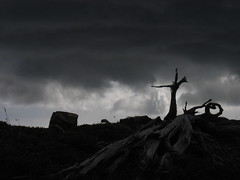
We ate dinner, and then Amanda crashed with hopes of a more sound night’s sleep than she had the previous nights. This time she had the added benefit of an Ambien tablet my mom had mailed me. My day wasn’t over yet, however. On our way into camp I noticed a sign indicating a look-out point over Grey Glacier about ten minutes away. I wanted to see it before sunset and it was already 8:50 by the time I finished washing the dishes. I took off running up the trail. Apparently I had enough energy for one last burst.
At the look-out I climbed to the top of the highest hill I could see. I found myself face-to-face with Grey Glacier. Its left arm formed a giant blue wall in front of me. I felt strangely alone without my travel companion. The view was intimidating. Here I was, surrounded by mountains, a lake at my side, a glacier staring at me, at the end of the world. I sat silently, letting the wind attack me, reflecting on the past week that I saw summarized before me in a single vista.
I wanted a picture of myself alone in this strange, remote place. I mounted my camera on the hillside and pointed it towards Grey Glacier. I set the ten-second timer and pressed the shutter button. Then I ran to the outcropping of rocks ahead of me and got ready. Suddenly, as the ten seconds counted down, I thought to myself I’m at the end of the world. I should do something outrageous. I picked up the largest rock I could find at my feet and held it over my head. I heard the shutter click. My batteries were too low for the instant gratification review we have come to expect from digital cameras. It didn’t matter; I already had the moment in my mind forever.
As it grew dark, I made my way back to camp and fell asleep.
Don’t miss the exciting conclusion to our adventure on Friday.
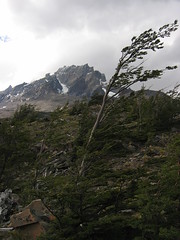
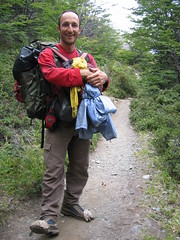
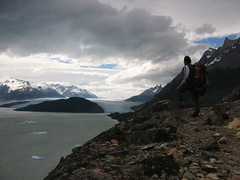

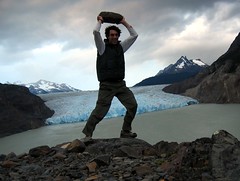

Comments